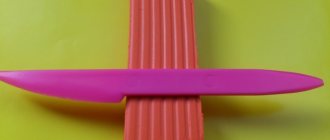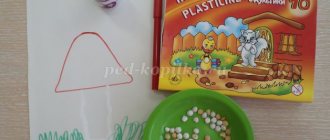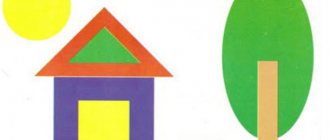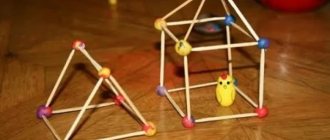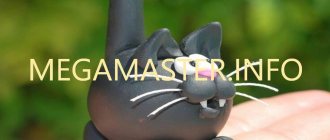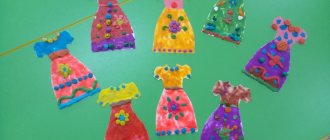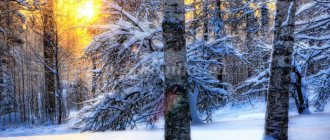Progress of the lesson:
Playback :Guys, guess the riddle:
The red tongue is not used to dozing.
Once or twice he licked all the wood. (fire)
Playback : What words helped you solve the riddle? (Red, licked all the wood)
Playback : You and I know how fire arises and who fights it. Just like in a real battle, firefighters suffer heavy losses in the fight against fire and constantly live a tense life full of anxiety from the dangers. This is a highly qualified service with an alarm system, powerful fire engines , pumping units, and special heat-protective suits. These people need to bow deeply for their work. It is necessary to respect their profession and be grateful for the work of these people, for their willingness to risk their lives to save others from harm. Tell me, how do firefighters get to a fire ? ( Firemen ride in cars )
Playback : Great, but our firefighters’ cars have broken down and they can’t save people. What should they do now? (We need to make fire trucks )
Playback : Let's help them and make fire trucks . And cars using a technique already known to you and me - plasticineography . But first we will stretch our fingers so that we can get precise lines.
One two three four five. (They move the machine forward and backward over each finger, starting with the thumb.)
The race can begin. (Now the same thing, but starting with the ring finger.)
In a circle, in a circle, forward and backward, (Now - in a circle in one direction and the other.)
But my fingers are slowing down my car . (Roll the machine again over the fingers , which are slightly bent.)
Closed. (They clench their fist.)
The car is already in the garage.
And the headlights went out, they don’t shine anymore. (They look into the small crack in the fist.)
Playback : Well done! We will carry out our work in three stages. And for this we need a sheet of cardboard, a simple pencil and colored plasticine .
Stage 1. Using a simple pencil, we draw the silhouette of a fire truck .
Stage 2. Apply red plasticine
Stage 3. Done! Now we need to add elements so that our machine
She looked like a firefighter . Add a ladder, a sleeve and number 01.
The children do the work.
An exhibition of fire engines . Children look at them, listen to the opinions of their comrades without interrupting them, and share their impressions.
Summary of direct educational activities in artistic creativity (drawing) on the topic “Fire Engine” Summary of direct educational activities in artistic creativity (drawing) on the topic “Fire Engine” Purpose: To consolidate.
Abstract of OOD on design in the preparatory group “Time Machine”. Program content: consolidate children's knowledge about time, professions, transport, continue to develop the skill of independently composing. Sculpting lesson notes. Plasticineography “Summer Forest” Tatyana Tuktamysheva Lesson summary on lenka (plasticineography) “Summer Forest” Goals and objectives: * development of fine motor skills * development of imagination. Master class “Do-it-yourself fire truck” All children really like to play with cars, and even girls! Children are especially attracted to construction equipment and special equipment. transport. And also kids. GCD for drawing in the preparatory group “A fire truck is rushing to a fire” “A fire truck is rushing to a fire” Program content: learn to convey proportions between objects and partial occlusion in a plot drawing. "Sunflower". Summary of a lesson on modeling using the non-traditional technique “plasticineography” in the middle group b] Goals and objectives. Teach children to create an image of a sunflower based on an unfinished composition (silhouette of a sunflower). Keep learning. Modeling lesson in the senior group “Here it is, the fragrant bread” (plasticineography) The children chose the theme for modeling on their own. Among all baked goods, bread turned out to be the most important, the most delicious, the most necessary.
Lesson in the preparatory group on sculpting “Fire Truck” (plasticineography)
Marina Smirnova (Solovieva)
Lesson in the preparatory group on sculpting “Fire Truck” (plasticineography)
Lesson in the preparatory group on sculpting “ Fire Engine ” ( plasticineography )
MBDOU "D/s No. 2 combined type"
preparatory group No. 2
Solovyova Marina Alekseevna
Educational: Teach children to draw “ Fire Truck ”
, achieve an accurate representation of the form, its structure and parts.
Developmental: Continue to develop an interest in working with plasticine using the familiar technique - plasticineography , develop fine motor skills.
Educational: to cultivate accuracy when doing work, to activate children’s imagination, to instill in children respect for a profession such as a firefighter , a respectful attitude towards their hard work, and an awareness of the dangers of this profession.
Preliminary work: Looking at illustrations with different types of transport, guessing riddles, reading poems on the topic, finger gymnastics “ cars ”
Materials and equipment:
Demonstration: photo of a fire truck .
Handout: Cardboard for each child, plasticine modeling board .
Looking at an illustration on the topic “ Fire Safety ”
; reading fiction.
Notes Nod in the middle group modeling on the topic "Transport"
Summary of GCD in the middle group
Modeling
Topic: Transport
Objectives of the lesson.
Cognition:
deepen and expand knowledge about ground transport. Learn to identify similar and different characteristics of passenger cars - size, color, shape; and car parts - trunk, hood, interior, wheels, steering wheel, etc. Give an idea of car models.
Communication:
development of coherent speech. Activation, expansion of the dictionary.
Artistic creativity:
develop the ability to paint over an image with plasticine – “Plasticineography”.
Material:
models of cars of various brands (or pictures of cars, see Appendix). A5 cardboard with a picture of a passenger car for painting (see appendix).
GCD move.
A car horn sounds. The teacher attracts the children and leads them to the cars on display.
Educator:
Today a car exhibition has come to visit you. Look carefully at the cars and tell me what this type of transport is called?
Children:
Ground, passenger.
Educator:
Right. How do you think these cars are similar?
Children
: All cars have wheels, headlights, hood, doors, interior, steering wheel, seats, trunk.
Educator
: Right. Now, guys, look and tell me, how are these cars different?
Children:
All cars are different colors. Different shapes of trunk, headlights. Some cars have different numbers of doors.
Educator:
Right. Why do you think they are so different?
(children's assumptions)
Educator:
Each plant produces different models of cars. Some people like black cars, some like red ones. If the family is large, then the number of seats in the car is needed. But some driver needs to transport cargo, for example, to the country, and he will choose a car with a large trunk. That’s why they produce different models of cars – for the convenience of people.
Educator:
So who can tell me why the cars are different and why they do it? (The teacher listens to the answers of several children and praises them.)
Gymnastics for the eyes “Follow the movement of the car” is carried out.
Physical education lesson “ We’re going, we’re going home.”
We're going, we're going home (movements simulating turning the steering wheel)
By car
We drove up the hill: bang. (Hands up, clap overhead)
The tire goes flat: stop. (Arms downwards, squat)
At the tables.
Educator:
Now I will give you images of a passenger car, but it is not painted and you will need to color it. And we will paint with plasticine. Who remembers how this is done? (Children's answers).
We remind the teacher how to work with plasticine: pinch off a piece and distribute it over the image. We don't go beyond the lines.
Educator:
Guys, we found out that cars come in different colors, depending on who you like. Therefore, you choose the color of the car yourself. What won't we paint over? (Window). Well done, get to work.
At the end of the activity, a work analysis is carried out. If the children do not have time to finish the work, it can be continued in the evening.
Technological map for sculpting “Machines” in the senior group
Irina Getman
Technological map for sculpting “Machines” in the senior group
Educational field: Creativity.
Section: Modeling .
Topic: Cars .
Goal: the ability to convey the characteristic features of a car using plasticineography techniques .
— deepen and expand children’s knowledge about ground transport;
- learn to identify similar and different characteristics of cars and trucks - size , color, shape;
- learn to identify parts of cars - trunk , hood, body, wheels, steering wheel, etc.;
— develop the ability to paint over an image of a car with plasticine;
— continue to introduce children to the unconventional drawing technique “plasticineography”
— conversation about cars and trucks;
- examination of subject pictures “Cars”
;
— reading poems and riddles about cars;
— p/i “Sparrows and Cars”
— cars;
— illustrations depicting cars;
“ machine ” handout
- blank images of cars (for each child)
There's a knock on the door. Guys, someone came to visit us, I’ll go and have a look. Bunny comes in.
Say hello to the guys! What a beautiful bunny, fluffy and soft.
Bunny, what happened to you, who scared you so much?
Guys, when I was walking towards you, I saw something like that on the street, they were honking, running fast, fast, beeping (honking, I was so scared, what was it?
Educator: Children, what do you think scared our bunny so much?
Children: cars
Bunny, sit and listen, the children will tell you everything they know about cars .
There are toy cars .
Educator: Children, what do you see on the table? These are cars , how many are there?
Educator: This is a passenger car, it has wheels, windows, a steering wheel.
car is this ?
Educator: Do you know what this car is called ?
This is a truck , it has a body, windows, and a steering wheel. The truck can transport ,
various loads in your body (sand, bricks, furniture)
.
Can we transport cargo in a small car
Bunny, now you know what cars , what types of cars there are .
Guys, when the Bunny goes home, how can he cross the road? Are there cars driving ?
Let's play with our hands
And remember about transport (connect fingers with thumb)
Let's fly on an airplane
Clouds, how are you living? (Represents the wings of an airplane)
Rocking in a boat
And we smile at the waves (Palms in a boat shape)
, depict waves)
We accelerate the motorcycle,
We play races (Clench your fingers into a fist, relax)
With wind, sun and friends. (Hands in a tube - blowing like a breeze)
; hands up are the rays of the sun. Hands point to friends)
Call transport with us. (Press the pads of the fingers against each other on the corresponding hands)
Bunny, now the guys will show you how you can make small cars from plasticine .
But we will not only sculpt, but also decorate our cars . You say, but we don’t have paints.
How will we paint with plasticine?
Let's sit down at the tables and paint the cars in bright colors .
(The teacher hands out car )
Familiarity with the depicted subject. Selecting a machine .
Showing the sequence of actions and sculpting .
1. Apply blue plasticine to the drawing, carefully, without going beyond the outline.
2.Now we need to add elements: wheels – black, headlights – yellow. Children choose any colors themselves.
You guys are so great! It turned out very well! Our cars are painted .
Reproduce: how to sculpt a car;
They understand: what parts the car consists of;
Apply: the ability to paint over an image of a car with plasticine, using the unconventional technique “plasticineography”
.
Technological map “Letters from the Queen of Mathematics” Technological map of organized educational activities in the senior group Educational area: “Cognition”. Section: "FEMP". Letter subject.
Summary of GCD for modeling using waste material in the middle group "Car"
Publications on the topic:
"Maple Leaf". Applique from paper and fabric using waste material Applique is one of the types of visual arts based on cutting out, overlaying various shapes and fixing them on another.
Summary of a lesson on sculpting using natural materials in the junior group “Walnut Mouse” Summary of a lesson on sculpting using natural materials in the junior group on the topic “Walnut Mouse”
Purpose: To fail.
Photo report on GCD for sculpting using natural material “Spiders on a cobweb” Photo report on GCD for sculpting using natural material “Spiders on a cobweb”. Goal: to develop the ability to sculpt a spider, conveying its characteristics.
Summary of GCD for sculpting using natural material “Chamomile” (second junior group) Summary of GCD for non-traditional modeling techniques Age: Second junior group Topic: “Chamomile” with pumpkin seeds Program objectives: Educational:.
Summary of a lesson on designing in the middle group, from waste material (candy wrappers) “The Cheerful Clown” Purpose: - to introduce children to circus performers, to the profession of a clown - to teach children to work with waste material (candy wrappers), - to teach.
"Cockerel." Master class made from paper using waste material from candy wrappers. A cheerful and magical New Year holiday is coming. Each of us has a lot of sweets at home, and therefore candy wrappers, I suggest you make them.
Master class “Children making crafts “Birdhouse on a tree” using waste material” MASTER CLASS CHILDREN MAKING CRAFTS “BOOKBOOK ON TREE” senior preschool age CRAFT “BOOKBOOK ON TREE” USING.
GCD plan for modeling “Mushrooms grow in our forest.” Collective composition using natural materials Goal: to consolidate ideas about mushrooms that grow in our forest, to show techniques for conveying their images in sculpting. Objectives: exercise.
Lesson in the middle group on modeling using natural material “Aquarium” (team work) Topic: “Our aquarium”. Goals: To intensify the use of various sculpting techniques to create beautiful aquatic plants and decorative fish; continue.
A lesson in modeling using natural materials in the middle group. Collective work “Aquarium” Class in a secondary group on modeling using natural material “Aquarium” (team work) Tatyana Zvyagina Class in a secondary group.
